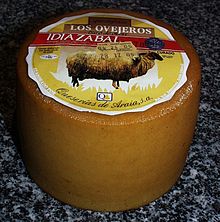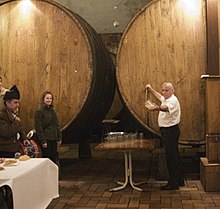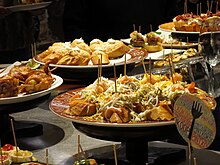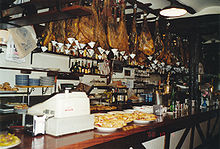Basque cuisine
The Basque cuisine is the local cuisine of the Basque country . It has elements from Spanish and French cuisine .
properties
The Basque cuisine is far from its proximity to the sea affected fish and seafood are popular meals. More beef than pork is generally consumed. Chicken is also popular, and horse butcher shops can be found in some towns and villages, albeit rarely .
Beef, such as B. fillets and chops , is grilled in the Basque Country . For the German taste, roasted meat is prepared rather bloody, practically raw on the inside and crispy on the outside.
Another peculiarity of Basque cuisine is the extensive lack of spices or herbs, which does not mean that Basque dishes are bland. Instead, the natural taste of the ingredients is emphasized, and the Basques also value the high quality of the components used.
In addition to traditional Basque cuisine, the New Basque cuisine has developed along the lines of French nouvelle cuisine .
Cuisine and cooking are very important in the Basque Country and many Basque chefs are known to the general public.
Meals
The meals during the day and their times correspond to those of Spanish cuisine . The people of the Gipuzkoa region eat up to an hour earlier than usual in Spain.
Basque Country dishes
- Angulas , glass eels
- Bacalao al Pil-Pil , stockfish with a sauce made from its own gelatine
- Bacalao a la Vizcaina , stockfish in paprika sauce
- Caracolillos or Karakelas , sea snails
- Chipirones en su tinta , squids in their own ink
- Chorizo a la Sidra , paprika sausage cooked in apple cider
- Chuletón de Vaca , beef chop
- Cuajada , a dessert made from sheep's milk
- Goxua , a sweet dessert made from pudding cream, cake batter, whipped cream and caramel
- Marmitako , tuna and potato stew
- Merluza en Salsa Verde , hake in a sauce made from oil , flour , peas and parsley , known as "green sauce"
- Pastel Vasco (French: Gateau Basque ), a cake made from shortcrust pastry with a cream filling from Iparralde , the French Basque Country
- Piperrada , a paprika dish
- Porrusalda , leek and potato stew
- Rape al Horno , Chicharro al Horno or Besugo al Horno , types of fish cooked in the oven
- Txangurro , spider crab ( span.centollo )
- Tortilla (de patata), potato omlette
Regional specialities
In the Basque Country there are a number of regional products that are also used in regional dishes.
- Alubias de Tolosa , black beans from Tolosa
- Chorizo de Orozko , paprika sausage from Orozko
- Idiazabal - cheese , a mature sheep cheese
- Pimientos de Gernika , green peppers from Gernika
- Txakoli , a dry white wine from Getaria
- Izarra , herbal liqueur from Bayonne
- Rioja wine from Álava
- Jambon de Bayonne , air-dried ham from Bayonne
Tradition and special features
Sociedades Gastronómicas
In the Basque Country, friends in clubs regularly get together to cook and then eat. These associations are called cooking societies or sociedades gastronómicas . Tradition dictates that only men of Sociedad be members. The society has its own clubhouse, which is equipped with a large kitchen and a dining room. Depending on personal preference, the members cook for themselves or with others, and there is always a lively atmosphere with food, drink and singing. Some members even visit the Sociedad daily.
Cooking societies can be found all over the Basque Country. They are particularly widespread in the province of Gipuzkoa (the region around Donostia-San Sebastián ) and in Donostia-San Sebastián alone there are 119, the oldest were founded in the 19th century . In Bizkaia the societies are called Txokos [ 'tʃokos ].
Cidereries
Sidra is cider that is very tart in the Basque Country. The Basques used to stock up on cider at the beginning of the year and so there is still a tradition today of trying the natural product apple wine from different barrels and then buying the best tasting one. The sidra-producing farms, the sidreries, open in the apple wine season, from mid-January to Easter. For the cider tasting, a menu is traditionally prepared that makes you thirsty: Cod omelette, cod with paprika, beef chop and for dessert, sheep's cheese with quince jelly (membrillo) and walnuts . During the meal, the guests drink the cider directly on the barrel.
In addition to the classic sidreries, which work in a similar way to an ostrich economy, there are sidrería restaurants that are open all year round outside of the cider season. Some serve the cider from bottles and many from dummy barrels. Cidereries are native to Gipuzkoa, in the rural suburbs of San Sebastián . Most of the classic ones are in Astigarraga , Hernani and Oiartzun . Sidreria restaurants can be found throughout the Basque Country and Navarre .
Pinchos
Many pubs and restaurants in the Basque Country offer pinchos under the Basque name pintxos , which are similar to Spanish tapas . These are small cold or warm dishes that are usually consumed with wine, beer or as an aperitif . See the main article Pincho .
Famous chefs and restaurants
- Arzak by Juan Mari Arzak in San Sebastián (3 stars according to the Michelin Guide )
- Akelarre by Pedro Subijana in San Sebastián (3 stars)
- Casa Nicolasa by José Juan Castillo in San Sebastián
- Karlos Arguiñano in Zarautz
- Martín Berasategui in Lasarte-Oria near San Sebastián (3 stars)
- Restaurante Guggenheim in Bilbao , also run by Martín Berasategui
Karlos Arguiñano in particular, but also Pedro Subijana and José Juan Castillo, are known for their work in the New Basque Kitchen for their cookery programs on Spanish television, in which they present simple and tasty dishes to cook at home.







